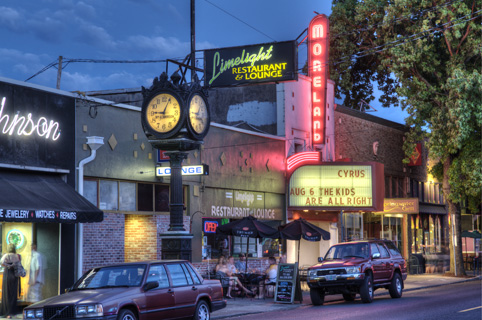 |
| Westmoreland district, Portland. Image: Ashley Brandt |
Picture a vibrant neighborhood business district in an American city – one that’s located outside of the downtown area. Or, envision the main street of one of your favorite small towns. Think cafes, restaurants with sidewalk seating, quirky stores, street trees, two- to four-story buildings close to the sidewalk, people strolling about.
Now, what is the car traffic like? Is it busy? Too busy? Not busy enough? Moving too fast? Not moving at all? Or is it just right?
Some might ask, isn’t the number of people walking along a main street more important than the traffic volume? In theory, yes, but not all of these people walked here directly from their houses. Some may have taken public transit or ridden their bikes. Many people probably drove and parked – either on their way to somewhere else, or specifically to visit this part of town.
The reality is, unlike in much of the rest of the world, American main streets need car traffic to thrive. If traffic volumes are too low, businesses don’t get the visibility they need to attract customers. American experiments in pedestrian-only main streets have been largely unsuccessful, with a few notable exceptions such as Church Street in Burlington, VT or Washington Street in Cape May, NJ.
Conversely, if traffic volumes are too high, the main street doesn’t feel safe and pleasant enough for people to stroll or eat an ice cream cone on the sidewalk. Major arterials with four or more lanes of heavy traffic have proven difficult to foster a pedestrian-friendly business environment. Instead, they often attract gas stations and discount stores. Only a few urban boulevards have bucked this trend – usually with major beautification and traffic calming investments.
 |
| Portland's Mississippi Avenue. Image: Scott Keith |
There are successful outliers, from Clinton Street’s modest 2,300 motorized vehicles (which join more than 3,000 daily cyclists on this busy bike boulevard), to the 18,000 vehicles seen daily on both Hawthorne and East Burnside (both 4-lane roads). But most good main streets are in the Goldilocks range. Three of them – Milwaukie Avenue in Westmoreland, inner Division Street and Belmont Street – have daily volumes around 12,000.
Once you surpass 20,000 vehicles per day, conditions for a traditional main street deteriorate, as seen on 82nd Avenue and Barbur Boulevard. Surpass 40,000 – as on McLoughlin Boulevard – and it’s very unlikely you will be able to create a pedestrian-oriented main street at all.
Of course other factors play into the success of a main street, particularly the economic characteristics of the surrounding neighborhood and urban design features like setbacks, massing, trees and transparency. Even within the transportation realm there are other factors to consider, such as parking availability, number of traffic lanes, sidewalk width and spacing of pedestrian crossings. But vehicle volumes are nevertheless an important indicator.
The table below reports average daily traffic volumes for 26 neighborhood business district main streets in Portland, listed in ascending order of average daily traffic. Those familiar with Portland will notice how the viability of these main streets drops off toward the bottom of the list.
 |
| Sources: Portland Bureau of Transportation and Oregon Department of Transportation |
I think there’s more potential along intersecting roads that have lesser volumes and fewer lanes, like Alexander Street in Aloha or Oak Grove’s namesake boulevard in Clackamas County. These collector streets are visible from the busier arterials, but offer a quieter, safer and more intimate setting for pedestrian-friendly businesses. One of Oregon’s best examples of this is 3rd Street in McMinnville, a cozy two-lane main street perpendicular to bustling Highway 99W.
I believe we should question the expectation that our busy, multi-lane arterial roads can also be excellent main streets. Perhaps we should focus our commercial revitalization efforts on the Goldilocks streets – the ones with 5,000 to 15,000 vehicles per day.
Yburis Infotech brilliant website design & web development company in the USA and India(Gurgaon) serving business worldwide and as you want to design according to the business model.
ReplyDeleteIf you need E commerce development company in faridabad so, you can contact us.
DeleteUnderstand how Mobile App Marketing works, and make it a part of your marketing strategy.
ReplyDeleteI am really thankful to have the information from this blog. Thanks a lot of you for giving us suitable information by your awesome post. Golden Triangle tour 6 days
ReplyDeleteNice post and nice information too. I read your post. 5 days Golden Triangle Tour is a tour package which will take you to all the famous spots of Delhi, Agra, and Jaipur. These India's most beautiful cities are having various places which wants only a visit and some praiseworthy words.
ReplyDeleteAgra is the city which has many beautiful attractions and they all just want a recognition by the aficionados of art and heritage buildings. Agra day tour by car is the tour package which is quite good enough for them.
ReplyDeleteThe incredible Same day Agra tour by Maharaja Express is an open golden door for you. What's more? The tour is proposed by a lot of travel agencies to explore this delightful and notable city.
ReplyDeleteThis grand city gives you feel like a monarch right from the day you step inside a magnificent palace. Here you can spend 2 days. With this city, the golden triangle tour comes to an end, leaving the visitor with enormous knowledge about the culture of India.
ReplyDeleteThe information was very good. Besides on a regular basis of using a computer if you are facing any issues with it then the professional team from ITFux can help you. For any kinds of laptop reparatur service, just call. ITfux can also give on-site service.
ReplyDelete